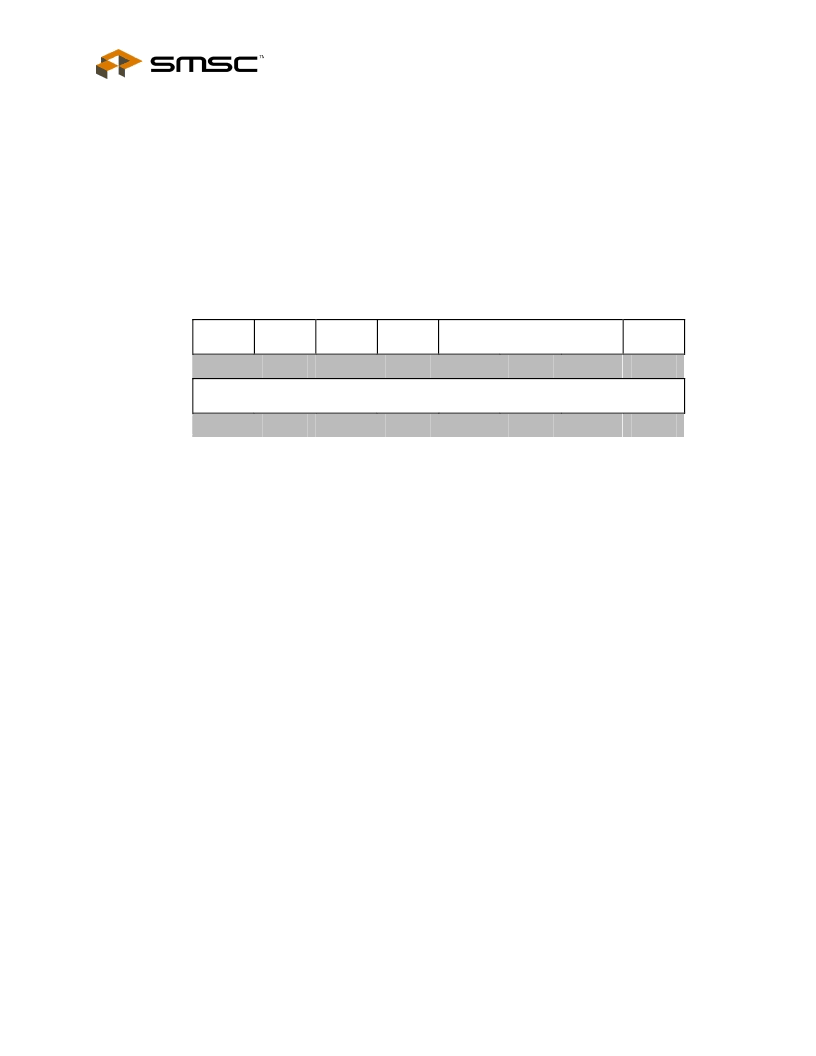- 您現(xiàn)在的位置:買賣IC網 > PDF目錄358742 > LAN91C95 LAN Node Controller PDF資料下載
參數(shù)資料
| 型號: | LAN91C95 |
| 英文描述: | LAN Node Controller |
| 中文描述: | 網絡節(jié)點控制器 |
| 文件頁數(shù): | 21/55頁 |
| 文件大?。?/td> | 482K |
| 代理商: | LAN91C95 |
第1頁第2頁第3頁第4頁第5頁第6頁第7頁第8頁第9頁第10頁第11頁第12頁第13頁第14頁第15頁第16頁第17頁第18頁第19頁第20頁當前第21頁第22頁第23頁第24頁第25頁第26頁第27頁第28頁第29頁第30頁第31頁第32頁第33頁第34頁第35頁第36頁第37頁第38頁第39頁第40頁第41頁第42頁第43頁第44頁第45頁第46頁第47頁第48頁第49頁第50頁第51頁第52頁第53頁第54頁第55頁

FEAST Fast Ethernet Controller
for PCMCIA and Generic 16-Bit Applications
SMSC DS – LAN91C110 REV. B
Page 21
Rev. 09/05/02
All memory related information is represented in 256 * M byte units, where the multiplier M is determined by the MCR
upper byte.
These register default to FFh, which should be interpreted as 256.
BANK 0
OFFSET
NAME
A
MEMORY CONFIGURATION
REGISTER
TYPE
SYMBOL
MCR
Lower Byte -
READ/WRITE
Upper Byte -
READ ONLY
HIGH
BYTE
MEMORY SIZE MULTIPLIER
0
0
1
1
0
1
0
1
LOW
BYTE
MEMORY RESERVED FOR TRANSMIT (IN BYTES * 256 * M)
0
0
0
0
0
0
0
0
MEMORY RESERVED FOR TRANSMIT - Programming this value allows the host CPU to reserve memory to be used
later for transmit, limiting the amount of memory that receive packets can use. When programmed for zero, the memory
allocation between transmit and receive is completely dynamic. When programmed for a non-zero value, the allocation is
dynamic if the free memory exceeds the programmed value, while receive allocation requests are denied if the free
memory is less or equal to the programmed value. This register defaults to zero upon reset. It is not affected by the
RESET MMU command.
The value written to the MCR is a reserved memory space IN ADDITION TO ANY MEMORY CURRENTLY IN USE. If the
memory allocated for transmit plus the reserved space for transmit is required to be constant (rather than grow with
transmit allocations) the CPU should update the value of this register after allocating or releasing memory.
The contents of the MIR as well as the low byte of the MCR are specified in units of 256 * M bytes, where M is the
Memory Size Multiplier. M=2 for the LAN91C110. A value of 04h in the lower byte of the MCR is equal to one 2K page (4
* 256 *2 = 2K); since memory must be reserved in multiples of pages, bits 0 and 1 of the MCR should be written to 1 only
when the entire memory is being reserved for transmit (i.e., low byte of MCR = FFh).
相關PDF資料 |
PDF描述 |
|---|---|
| LAN91C100FD(208TQFP) | LAN Node Controller |
| LAN91C100FD(208PQFP) | LAN Node Controller |
| LAN91C94 | ISA/PCMCIA SINGLE CHIP ETHERNET CONTROLLER WITH RAM |
| LAN91C110TQFP | FEAST FAST ETHERNET CONTROLLER FOR PCMCIA AND GENERIC 16-BIT APPLICATIONS |
| LAN91C96I | NON-PCI SINGLE-CHIP FULL DUPLES ETHERNET CONTROLLER |
相關代理商/技術參數(shù) |
參數(shù)描述 |
|---|---|
| LAN91C95TQFP | 制造商:Rochester Electronics LLC 功能描述:- Bulk 制造商:SMSC 功能描述: |
| LAN91C95TQFP WAF | 制造商:SMSC 功能描述: |
| LAN91C96 | 制造商:SMSC 功能描述: |
| LAN91C96(100QFP) | 制造商:未知廠家 制造商全稱:未知廠家 功能描述:LAN Node Controller |
| LAN91C96(100TQFP) | 制造商:未知廠家 制造商全稱:未知廠家 功能描述:LAN Node Controller |
發(fā)布緊急采購,3分鐘左右您將得到回復。